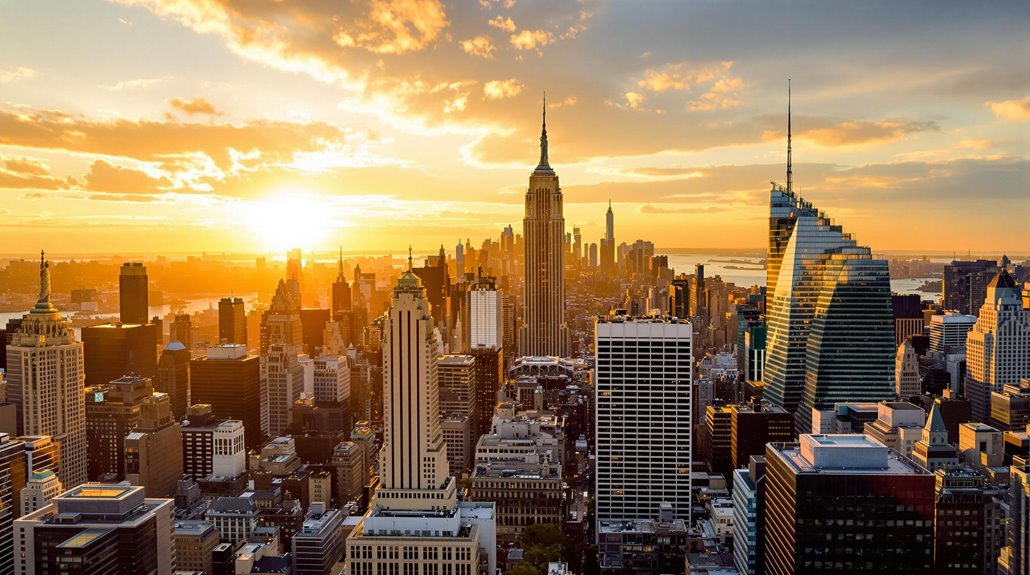You should consider investing in New York due to its robust economic landscape, boasting a GDP exceeding $2 trillion. The city’s real estate market is diverse, with an office inventory of over 664 million sq. ft. and low vacancy rates. Green initiatives like Local Law 97 carve a path toward sustainability, providing tax benefits and aligning with global trends. New York’s cultural vibrancy and strong talent pool from prestigious institutions attract a diverse workforce, enhancing business ecosystems. With these strategic advantages, exploring further will reveal even more about how New York remains a prime investment destination.
Key Takeaways
- New York’s GDP surpasses $2 trillion, positioning it as one of the largest global economies with substantial economic resilience.
- The real estate market shows strong growth, with rising home prices and low rental vacancy rates indicating high investment potential.
- NYC promotes sustainable development through incentives like Local Law 97, enhancing long-term real estate value.
- A diverse and skilled workforce with over 600,000 college students supports business innovation and growth opportunities.
- The city’s vibrant cultural scene and robust public transportation system enhance quality of life, attracting residents and investors alike.
Economic Resilience
Economic resilience is a hallmark of New York City’s dynamic market, offering investors a compelling reason to contemplate its opportunities. With a gross metropolitan product (GMP) of $2 trillion, New York City outpaces entire national economies like South Korea and Australia, underscoring its formidable economic stability. This robustness is particularly attractive for new york real estate investment, as it provides a foundation of reliability amidst global economic fluctuations.
The city’s diverse economic base, spanning finance, real estate, media, and technology, acts as a stabilizing force against downturns. This diversity guarantees that as one sector faces challenges, others can buoy the economy. For investors, this translates into a consistent demand for properties, making new york property appreciation a tangible reality. The recent data reflects this, with the MSA House Price Index reporting a 9.7% year-on-year increase as of December 2023, signifying investor confidence and robust market recovery.
Moreover, New York’s rental market remains strong, with average monthly rents reaching $3,347. This is a clear indicator of sustained demand for housing, even when homeownership rates decline. This trend not only supports property appreciation but also assures investors of a steady income stream through rental properties. Understanding market dynamics strengthens investment strategies, enabling investors to make informed decisions and capitalize on emerging opportunities.
The city’s global appeal is further amplified by substantial foreign investments, particularly from Chinese investors, who have injected around $5 billion into the NYC property market over the past four years. This influx of foreign capital highlights New York’s economic strength and its status as a desirable investment destination.
Office Market Potential
New York City’s office market stands as the most valuable in the United States, boasting over 664 million square feet of inventory that surpasses the combined offerings of Chicago and Washington, D.C. This vast footprint positions New York commercial property as a prime target for savvy investors. With cap rates consistently attractive between 4-6% over the past decade, the market provides a stable and appealing investment opportunity.
Despite economic fluctuations, NYC’s office market has shown remarkable resilience, with recovering rents and improving vacancy rates. This adaptability makes New York City investment a prudent choice for those looking to balance risk and reward. Central business districts in NYC, well-known for their strategic locations and economic robustness, continue to draw substantial institutional investments.
It is vital for investors to stay updated on rental market analysis to ensure they make informed decisions and maximize profitability over time.
| Factor | NYC Office Market | Significance |
|---|---|---|
| Total Inventory | 664+ million sq. ft. | Largest in U.S., surpasses Chicago and D.C. |
| Cap Rates | 4-6% | Indicates stable investment potential |
| Economic Resilience | High | Consistently recovers from market shocks |
The ongoing commitment to modernize through initiatives like Local Law 97 and tax incentives such as M-CORE further enhances the appeal of New York commercial property. These programs not only improve the sustainability of buildings but also secure long-term value growth. For investors, this means tapping into a market that’s not just vast and robust, but forward-thinking and adaptable.
Green Initiatives

You’re looking at a strategic opportunity with New York City’s aggressive sustainability programs like Local Law 97, which targets a 40% reduction in greenhouse gas emissions by 2030. Tax incentives such as the M-CORE and ICAP programs make investing in energy-efficient renovations financially appealing, enhancing property value and tenant satisfaction. By aligning with these green initiatives, you’re positioning your investments for higher occupancy rates and rental income in a market that prioritizes sustainable practices. Additionally, New York’s commitment to infrastructure development signals future growth potential and increased property values.
Sustainable Real Estate Programs
In the domain of sustainable real estate, New York City stands as a pioneering force, driven by ambitious regulations and attractive incentives. Local Law 97 is a key driver, mandating significant reductions in greenhouse gas emissions from large buildings. This regulation opens new york investment opportunities by pushing the commercial real estate sector towards sustainable practices. The M-CORE initiative further propels this shift, offering tax benefits for transformative renovations in Manhattan. Such initiatives don’t just enhance New York luxury real estate; they strategically position buildings for long-term value and tenant satisfaction.
The NYC Economic Development Corporation (NYCEDC) plays an essential role by connecting investors with sustainable real estate opportunities. Their efforts are complemented by the Industrial and Commercial Abatement Program (ICAP), which promotes greener building practices while fostering growth in the commercial market. This convergence of policy and market trends underscores a broader shift towards environmentally friendly real estate investments.
Investing in sustainable real estate in NYC isn’t just about compliance; it’s a strategic move that aligns with market trends. By reducing operational costs and enhancing property value, these initiatives guarantee that your investment is both profitable and future-proof.
Tax Incentives for Renovations
Building on the momentum of sustainable real estate initiatives, tax incentives for renovations offer strategic opportunities for investors looking to maximize returns in New York City. The M-CORE program exemplifies this by providing new york tax benefits for commercial buildings, particularly south of 59th Street in Manhattan. This initiative supports modernization and sustainability, aligning with prevailing new york real estate trends focused on eco-friendly development.
Local Law 97 further compels property owners to reduce greenhouse gas emissions, greatly impacting the decision to invest in green renovations. By doing so, investors not only avoid substantial fines but also enhance property values and decrease operational costs—two tangible advantages that stem from energy-efficient upgrades. Programs like ICAP amplify these benefits by offering property tax abatements for improvements on commercial properties, fostering sustainable investment practices.
Moreover, the NYC Economic Development Corporation (NYCEDC) plays an essential role by connecting investors with viable real estate opportunities that qualify for these green initiatives. This not only promotes economic growth but also underscores New York City’s commitment to environmental responsibility. Consequently, strategic investment in sustainable renovations aligns well with both regulatory obligations and emerging market trends.
Energy Efficiency Legislation
Energy efficiency legislation in New York City, especially Local Law 97, mandates substantial reductions in greenhouse gas emissions for large buildings, compelling property owners to embrace energy-efficient renovations. This requirement isn’t just about compliance; it’s a strategic opportunity to enhance property value and reduce long-term operational costs. With over 50% of the city’s carbon emissions stemming from buildings, these initiatives are vital. As an investor, aligning with these regulations can position you advantageously in the New York housing market.
The M-CORE program sweetens the deal with tax benefits for commercial renovations focused on sustainability. By modernizing your properties, you not only avoid hefty fines but also potentially lower your new york property taxes. New York’s ambitious goal to cut emissions by 40% by 2030 underscores a serious commitment to sustainability, providing a roadmap for strategic investments in energy-efficient technologies.
Incentives like the ICAP program further bolster the appeal of green real estate projects. These incentives make adopting green technologies financially viable, offering a competitive edge in the market. By investing in energy-efficient upgrades, you’re not only contributing to environmental goals but also capitalizing on a significant market opportunity.
Real Estate Trends
When considering New York’s real estate market, you’ll notice a 9.7% increase in the MSA House Price Index, underscoring rising property values and robust demand. With the average home price at $628,951, coupled with a rental vacancy rate of just 3.5%, the city’s market offers significant investment potential. As rental prices climb by 11.3% year-over-year, investing in New York’s property sector strategically positions you to capitalize on strong rental demand and asset appreciation. The importance of location in multifamily investments is evident in New York, where proximity to amenities and employment centers significantly impacts property desirability and rental demand.
Rising Property Values
New York’s real estate market is undeniably on an upward trajectory, bolstered by a 20.6% surge in home prices over the past three years. This trend underscores the strategic advantage of entering the New York rental market or choosing to buy New York property. The median home value stands at $628,951 as of December 2023, reflecting a competitive market with notable appreciation potential. Such consistent growth indicates that investments here are likely to yield substantial returns.
Analyzing the data further, the MSA House Price Index for New York reveals a year-on-year growth of 9.7% as of December 2023, reinforcing the city’s robust real estate landscape. Long-term growth can be observed in townhouse prices, which have skyrocketed by 58.3% from 2007 to 2016. With ongoing development projects set to introduce 70,000 new apartments in Queens and 110,000 in Brooklyn, demand and property values are expected to climb even higher.
As an investor, it’s critical to recognize these upward trends and capitalize on them. Whether you’re considering entering the New York rental market or aiming to buy New York property, the data clearly supports a strategic investment in this thriving real estate market.
Strong Rental Demand
Given the impressive rise in property values, a compelling factor in New York’s real estate market is the strong rental demand. With a rental vacancy rate of just 3.5%, considerably below the national average of 5.9%, New York City’s rental market is fiercely competitive. This low vacancy rate, combined with a staggering 97.1% occupancy, highlights the intense demand for housing. Renters are often engaged in bidding wars, further driving up prices.
Strategically, investing in New York short-term rentals and New York vacation rentals can be particularly lucrative. The average monthly rent in NYC is $3,347, with an annual increase of 3.8%. This trend signals sustained upward pressure on rental prices, making it an attractive market for investors. The year-on-year rent surge of 11.3% indicates that as pandemic concessions expire, rental costs will likely rise further.
New York City’s population growth and economic recovery post-pandemic have bolstered this robust rental market. For investors, this means a steady stream of potential tenants and a constant opportunity for income generation. Given these dynamics, New York stands out as a prime location for rental property investment.
Cultural and Lifestyle Appeal
 Although investment opportunities abound globally, New York City’s cultural and lifestyle appeal stands out as a compelling reason to contemplate this vibrant metropolis. The city boasts over 2,000 arts and cultural organizations, including iconic institutions like the Metropolitan Museum of Art and Broadway theaters. This dynamic New York culture attracts millions of visitors annually, enhancing the city’s economic landscape and providing a lucrative environment for investors. The diverse population fuels a unique New York lifestyle, offering a wide range of cuisines, festivals, and cultural events. This diversity not only enriches the living experience but also drives demand for real estate, as people flock to neighborhoods with high-quality living conditions and amenities. Consequently, tenant satisfaction is high, increasing the demand for rental properties. Understanding tenant preferences leads to targeted property offerings, increasing tenant satisfaction.
Although investment opportunities abound globally, New York City’s cultural and lifestyle appeal stands out as a compelling reason to contemplate this vibrant metropolis. The city boasts over 2,000 arts and cultural organizations, including iconic institutions like the Metropolitan Museum of Art and Broadway theaters. This dynamic New York culture attracts millions of visitors annually, enhancing the city’s economic landscape and providing a lucrative environment for investors. The diverse population fuels a unique New York lifestyle, offering a wide range of cuisines, festivals, and cultural events. This diversity not only enriches the living experience but also drives demand for real estate, as people flock to neighborhoods with high-quality living conditions and amenities. Consequently, tenant satisfaction is high, increasing the demand for rental properties. Understanding tenant preferences leads to targeted property offerings, increasing tenant satisfaction.
| Metric | Value | Impact on Investment |
|---|---|---|
| Arts & Cultural Orgs | Over 2,000 | Attracts millions of visitors |
| Annual Tourists | 58.5 million | Boosts local economies |
| Transportation Connectivity | Extensive | Enhances accessibility |
| Major Attractions | Central Park, Times Square | Increases property values |
Moreover, the city’s major attractions like Central Park and Times Square draw approximately 58.5 million tourists each year. This influx considerably boosts local economies and elevates property values, making real estate investment particularly attractive. New York’s extensive public transportation system further solidifies its status as a premier investment destination. The connectivity guarantees easy access for both residents and tourists, making the city even more appealing.
Strategic Location
As a global hub, New York City strategically positions itself as a vital nexus for international businesses and markets. Its central location on the East Coast makes it an ideal base for companies aiming to engage with both domestic and international clients. This geographic advantage facilitates efficient travel and commerce, bolstering economic activity and attracting diverse industries.
New York’s robust transportation infrastructure is a key factor in its strategic appeal. With multiple airports and an extensive network of subways and rail systems, New York public transportation offers seamless connectivity that businesses and residents rely on. This accessibility guarantees that companies can easily connect with global partners, clients, and markets, while employees benefit from efficient commutes, sustaining the city’s dynamic economic environment.
The presence of numerous Fortune 500 companies and major financial institutions in New York City underscores its role as a vital economic center. This concentration of industry leaders not only attracts top-tier talent but also generates a wealth of New York finance jobs, further enhancing the city’s standing as a financial powerhouse. The synergy created by this ecosystem of businesses and talent amplifies opportunities for investment and growth.
Moreover, New York’s proximity to leading cultural, educational, and research institutions fosters an environment ripe for innovation and collaboration. This unique blend of resources and expertise supports both startups and established enterprises, making the city an attractive location for strategic investment. By leveraging New York’s strategic location, you position your business to thrive in a globally connected, economically vibrant setting.
Conclusion
Investing in New York is like planting seeds in fertile soil; it’s a strategic move backed by data on its economic resilience and office market potential. The city’s green initiatives and evolving real estate trends create a robust foundation for growth. Its cultural and lifestyle appeal, coupled with a strategic location, paints a vivid picture of opportunity. You’re not just betting on a city; you’re aligning with a powerhouse that’s proven to weather economic storms and thrive.




